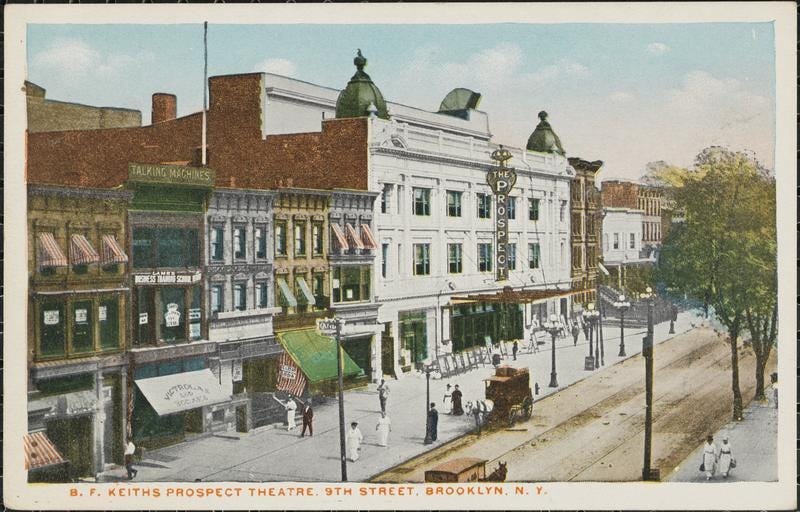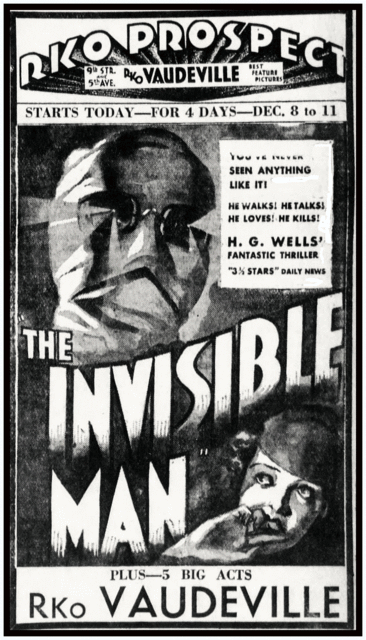Park Slope’s Hidden History: 9th Street’s Vaudeville Theater
Did The Three Stooges get their big break in Park Slope?

As Park Slopers, we are fortunate to live in a community that’s filled with architectural marvels. Our neighborhood is brimming with Victorian mansions and historic brownstones that make up 40 blocks of a landmarked historic district. Even the buildings without a landmark designation sign carry a storied history. One such historical site is 329 9th Street between 5th and 6th avenues. Though originally constructed in 1914, this building now blends in with its many neighbors along 9th Street. But like most structures in our neighborhood we have to dig deeper, or in this building’s case - upward, to discover its past as Park Slope’s Prospect Theatre.
Labor reforms and improved workers' rights at the turn of the twentieth century gave hardworking New Yorkers more leisure time. Park Slope residents could now spend more time with their families and enjoy many different forms of entertainment together. One of New York City’s most popular pastimes in the early 1900s was vaudeville. Vaudeville shows were often short acts that featured many different kinds of theatrical performances, from singers and comedians to magicians and acrobats. Vaudeville theaters were usually open from early morning to late at night which meant that entertainers were constantly cycling on and off of the stage. This gave flexibility to theatergoers who could enjoy many types of entertainment throughout the day.
At the turn of the century, New York City was home to dozens of theaters dedicated to showcasing vaudeville performances. One of the most famous was the Palace Theatre in Manhattan, which still exists today. The Palace featured performers who were booked under the B. F. Keith Circuit, which was a chain of vaudeville theaters owned by one company. New England businessman Benjamin Franklin Keith created his circuit to showcase the many acts that he managed and to generate a large profit. As the demand for vaudeville grew, in 1913 the B.F. Keith Circuit expanded into Brooklyn and began construction on B.F. Keith’s Prospect Theatre in Park Slope.
Architect William H. McElfatrick was tasked with creating this new epicenter of vaudeville entertainment. Situated on 9th Street, McElfatrick’s ornate theater featured lobby walls made of marble and theater walls lined with silk. In an article from September 2nd 1914, the Brooklyn newspaper Home Talk the Item chronicles the marvels of McElfatrick’s creation:
“Not a particle of wood used in construction. Girder supporting balcony weighs 60 tons. No posts in building to obstruct view of stage. Is absolutely fireproof. Has 26 exits, which is more than law requires. 12,000,000 bricks were used in construction. Has 7,500 lights. Balcony is strong enough to support world’s ten heaviest locomotives. Is largest vaudeville house in Greater New York.”
The theater was the largest in the neighborhood and could house up to 2,500 patrons. Though media coverage referred to it as “the woodless and post-less theatre” it was incredibly sturdy due to the large beams used in its construction. Known as the “Prospect Theatre” to locals, it opened to the public on September 7th 1914. The Brooklyn Daily Times, which recorded the spectacular opening celebration, quoted Brooklyn Borough President Lewis H. Pounds’ congratulatory message which read:
“By building one of the finest theaters in the United States in the heart of Brooklyn, the Keith interests have paid a tribute to the wonderful growth of the borough and have indicated their belief in its great future.”
B.F. Keith Circuit vaudeville acts soon took to the stage. In 1922 Ted Healy, a popular comedian from Brooklyn, was performing his vaudeville show at the Prospect when the acrobat in his act suddenly quit. Healy, desperate to quickly find a replacement, asked his childhood friend Moses Horwitz to step in. What started as a one-week stint eventually led to an eleven year partnership between Healy and Horwitz. Moses Horwitz changed his name to Moe Howard, and along with Healy created the act “Ted Healy and His Stooges.” This chance collaboration laid the groundwork for The Three Stooges, launching a legendary run on stage and screen.

~~~ Behind the paywall: Find out what happened to Park Slope’s grand old theater, what it became & what is still hidden there, and how the Three Stooges returned decades after their debut. ~~~


